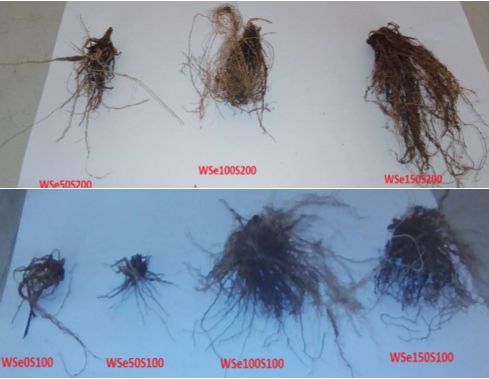Alleviating Salinity Stress in Wheat using Selenite Seed Primed
David Oyinade Aderoju*, Ajiboye Abiodun Akeem, Akomolafe Gbenga Festus, Agbolade James Oludare4, Ojo Mercy Boyede, Jolayemi Okanlawon Lekan, Olawuni Idowu Julius
Research Article | Published: 11 January, 2019
First Page: 114
Last Page: 118
Views: 4256
Keywords: salinity, selenite, yield, wheat, nutritional and reproduction character
Abstract
Salinity stress is an important abiotic stress that adversely affects food production. Selenite is a vital micronutrients required by plants for their physiological growth. The present study is aimed at the effect and dosage of selenite on the germination, emergence growth, reproductive characters, yield and nutritional composition of wheat under salinity stress. Seeds were soaked in different concentrations 0mg/l, 50mg/l, 100mg/l and 150mg/l of Se for eight hours at 26oC. They were rinsed and dried back to their initial moisture contents. Primed seed were sown. Plants were irrigated eight times with saline water at concentrations of 0 mM, 100 mM and 200mM. When there was no stress, selenite delayed germination of wheat seeds at the beginning, hastening flowering at higher concentrations (100-150mg/l) and drastically improved 31% and 25% growth of radicle and plumule at low concentration (50mg/l) than other treatments. Whereas, during salinity stress, selenite stimulated 25% shoot/root ratio and improved nutritional contents (15% protein and 10 % vitamin C) of wheat was obtained at low concentration (50mg/l). However, selenite at high concentration (100mg/l and 150mg/l) triggered floral budding thus produced greater grain and biomass yield during salinity stress. Therefore, selenite improved the reproduction, yield and nutritional value of wheat under salinity stress. However, wheat reproduction and its development in selenite seed-primed is concentration dependent.

References
- Parihar P, Singh S, Singh R, Singh VP and Prasad SM (2015) Effect of salinity stress on plants and its tolerance strategies: A review. Environ Sci Pollut Res 22: 4056–4075
- Shanker AK and Venkateswarlu B (2011) Abiotic stress in plants—mechanisms and adaptations. In: TechJaneza Trdine 9, 51000 Rijeka, Croatia
- Ahmad P, Hakeem KR, Kumar A, Ashraf M and Akram NA (2012) Salt-induced changes in photosynthetic activity and oxidative defense system of three cultivars of mustard (Brassica juncea L.). Afr J Biotechnol 11: 2694–2703
- Mantri N, Patade V, Penna S, Ford R and Pang E (2012) Abiotic stress responses in plants: present and future. In: Ahmad P., Prasad MNV (eds) Abiotic stress responses in plants: metabolism, productivity and sustainability. Springer, New York. Pp 1–19
- Thakur P, Kumar S, Malik JA, Berger JD and Nayyar H (2010) Cold stress effects on reproductive development in grain crops: An overview. Environ Exp Bot 67: 42 9–443
- Munns R (2005) Genes and salt tolerance: bringing them together. New Phytol 167: 645–663
- Zhu JK (2001) Plant salt tolerance. Trends Plant Sci 6: 66–71
- Grattan SR and Grieve CM (1999) Salinity-mineral nutrient relations in horticultural crops. Sci Hort 78: 127–157
- Hu Y and Schmidhalter U (2005) Drought and salinity: a comparison of their effects on mineral nutrition of plants. J Plant Nutr Soil Sci 168: 541–549
- Oertli JJ (1991) Nutrient management under water and salinity stress. In: Proc Symposium on nutrient management for sustained productivity, Punjab Agric Univ Ludhiana, India. Pp 138–165
- Nahar K and Hasanuzzaman M (2009) Germination, growth, nodulation and yield performance of three mung bean varieties under different levels of salinity stress. Green Farm 2: 825–829
- Hartikainen H, Xue T and Piironen V (2000) Selenium as an antioxidant and pro-oxidant in ryegrass. Plant Soil 225: 193–200.
- Feng R, Wei C and Tu S (2013) The roles of selenium in protecting plants against abiotic stresses. Environ Exp Bot 87: 58-68.
- Djanaguiraman M, Durga D, Shanker AK, Sheeba A and Bangarusamy U (2004) Selenium – An antioxidative protectant in soybean during senescence. Plant Soil 272: 77–86.
- Hanson B, Garifullina GF, Lindblom SD, Wangeline A, Ackley A, Kramer K, Norton AP, Lawrence CB and PilonSmits AH (2003) Selenium accumulation protects Brassica juncea from invertebrate herbivory and fungal infection. New Phytol 159: 461–466.
- Hawrylak-Nowak B (2009) Beneficial effects of exogenous selenium in cucumber seedlings subjected to salt stress. Biol Trace Elem Res 132(1-3): 259-269.
- Diao M, Ma L, Wang J, Cui J, Fu A and Liu HY (2014) Selenium promotes the growth and photosynthesis of tomato seedlings under salt stress by enhancing chloroplast antioxidant defense system. J Plant Growth Reg 33(3): 671-682.
- Hasanuzzaman M, Hossain MA and Fujita M (2011) Selenium-induced up-regulation of the antioxidant defense and methylglyoxal detoxification system reduces salinity-induced damage in rapeseed seedlings. Biol Trace Elem Res 143(3): 1704-1721.
- Holme D and Peck H (1998) Amino acids 8 Proteins. Analyt Biochem 3: 342-405.
- Lowry OH, Rosebrough NJ, Farr AL and Randall RJ (1951) Protein measurement with the Folin phenol reagent. J Biol Chem 193(1): 265-275.
- Hawrylak-Nowak B, Matraszek R and Pogorzelec M (2015) The dual effects of two inorganic selenium forms on the growth, selected physiological parameters and macronutrients accumulation in cucumber plants. Acta Physiol Plant doi:10.
- 1007/s11738-015-1788-9
- Lehotai N, Lyubenova L, Schröder P, Feigl G, Ördög A, Szilágyi K, Erdei L and Kolbert Z (2016) Nitro-oxidative stress contributes to selenite toxicity in pea (Pisum sativum L). Plant Soil 400: 107–122.
- Khaliq A, Aslam F, Matloob A, Hussain S, Geng M, Wahid A and H Rehman (2011) Seed Priming with Selenium: Consequences for Emergence, Seedling Growth, and Biochemical Attributes of Rice. Biol Trace Elem Res 015-0260-4
- Hartikainen H (2005) Biogeochemistry of selenium and its impact on food chain quality and human health. J Trace Elem Med Biol 18:309–318
- Sajedi NA (2017) Evaluation of selenium and salicylic acid effect on physiological and qualitative characteristics of dry-land wheat cultivars. Iran Agric Res 36(2) 91-100
- Nawaz F, Ashraf MY, Ahmad R and Waraich EA (2013) Selenium (Se) Seed Priming Induced Growth and Biochemical Changes in Wheat Under Water Deficit Conditions. Biol Trace Elem Res 151:284–293
Author Information
Department of Plant Science and Biotechnology, Federal University Oye-Ekiti, Ekiti State, Nigeria